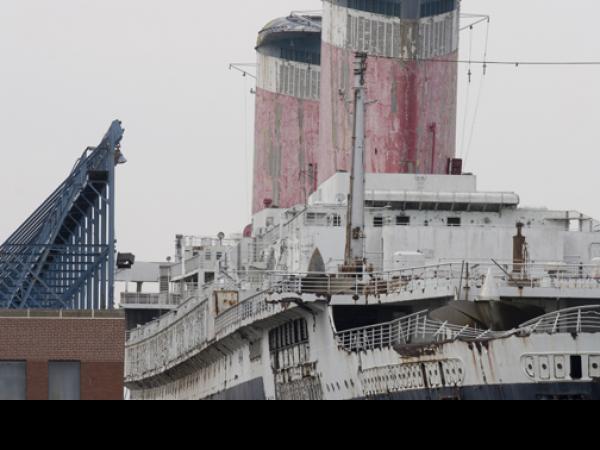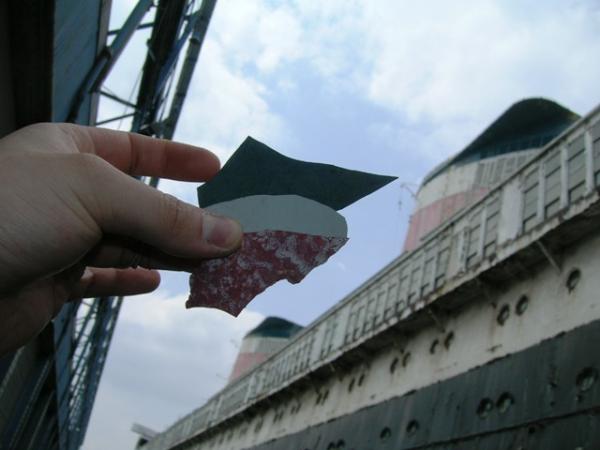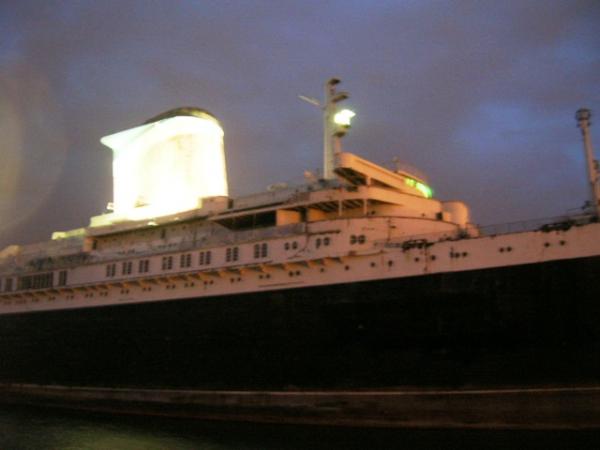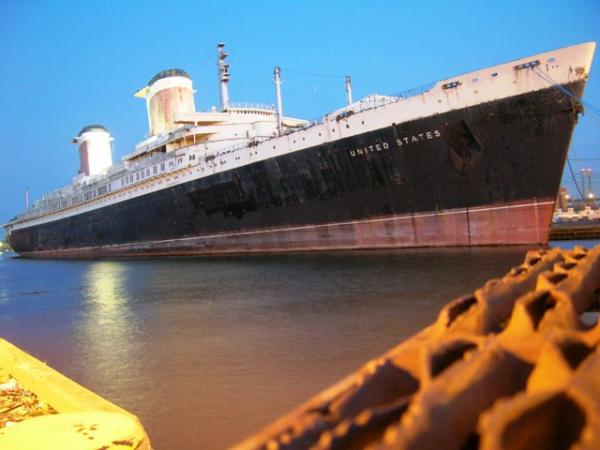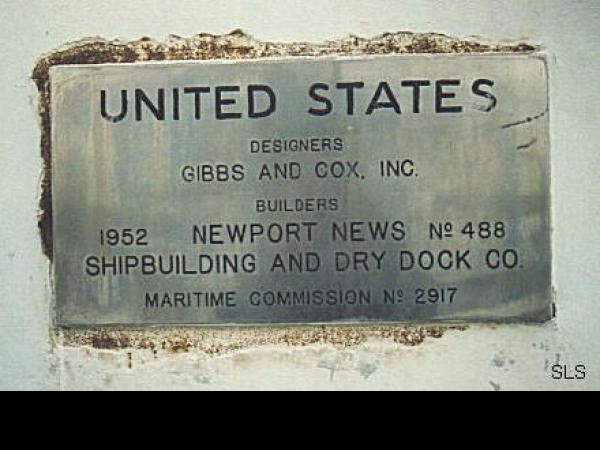Breaking news: A reprieve for the SS United States
By Steven B. Ujifusa
For PlanPhilly
At Thursday night’s National Flagship Celebration at the South Philadelphia IKEA, the SS United States Conservancy will formally announce that philanthropist H.F. (“Gerry”) Lenfest has donated $5.8 million towards the maintenance and eventual purchase of the SS United States from Genting Hong Kong Ltd.
The SS United States Conservancy has finalized an exclusive purchase option on the famous ocean liner, and full title transfer will occur once pending negotiations with the Environmental Protection Agency are complete.
Tonight’s festivities, which are open to the public, will begin at 7 p.m. They will include remarks by Mayor Michael Nutter, an outdoor screening of the American Public Television documentary SS United States: Lady in Waiting, and the floodlighting of the ship’s funnels, bridge, radar mast, and running lights. Lenfest will be in attendance.
Joe Rota, one of many former crewmembers who will be attending the celebration on July 1, is amazed at the recent turn of events. “If there was ever an angel who was in charge of American icons that must be saved,” Rota said, “it is Gerry Lenfest. His contribution, foresight and generosity in saving the SS United States is a now a legend.” Rota worked aboard the “Big U” as a bellboy, waiter, and ship’s photographer during her heyday in the 1950s.
Last summer, Lenfest pledged a $300,000 matching grant towards the purchase of the ship. But his major intervention began on March 10, 2010, a month after Genting Hong Kong opened up bidding on the ship to domestic scrappers. Over the past several months, Lenfest has worked closely with the board of the SS United States Conservancy to stop the ship from being towed away to a Gulf Coast junkyard.
The fading ocean liner has been moored on the Delaware River for the past fourteen years. Norwegian Cruise Line and its major stakeholder, Genting Hong Kong, purchased the ship in 2003 with the intention of restoring her to American-flag cruise service. However, in early 2009 the company announced they were abandoning these plans and were listing the SS United States for sale, with the provisions that the ship would neither be sold to a foreign entity nor sold for scrap. After a year, however, Genting lifted the “no scrappers” provision, and domestic shipbreakers quickly began submitting bids.
Lenfest’s connection to the sea began at a young age: his naval architect father helped designed the watertight doors on the ship’s smaller running mate, SS America, and Lenfest believes his father did similar work on the SS United States. After graduating from Washington and Lee University in 1953, Lenfest served as an officer in the United States Navy. Although trained as a lawyer, Lenfest took a job at Walter Annenberg’s Triangle Publications, and then went on to form his own media company. In 2000, he sold Lenfest Communications to Comcast. He then pledged to give away all of his multi-billion dollar fortune before his death. Recent beneficiaries of Lenfest’s generosity include Columbia University, Washington and Lee University, Abington Memorial Hospital, and the Curtis Institute of Music.
For the time being, Lenfest’s eleventh-hour intervention has saved the ship from almost-certain destruction. “This is obviously a game-changer in our years-long effort to preserve this irreplaceable American icon,” said Susan Gibbs, board president of the Conservancy and granddaughter of the vessel’s designer, Philadelphia-native William Francis Gibbs. “We are extremely grateful to Mr. Lenfest for his visionary leadership and generosity in helping us breathe new life into our great national flagship.”
Despite Lenfest’s donation, the ship’s future is still far from certain. According to the Conservancy, the exclusive purchase option is a stay of execution, not a guaranteed salvation. When the ship is purchased by the SS United States Conservancy, the nonprofit is charged with raising the funds needed renovate the ship as a stationary, floating attraction, moored either in New York or Philadelphia.
Conservancy consultants are currently in talks with parties in both cities to determine if the ship could be a viable addition to their urban waterfronts. A new entity, the SS United States Conservancy Development Corporation, may be involved in the development side of the venture.
Support has been growing for the ship to remain in the city of her designer’s birth. In late September 2009, City Council President Anna Verna wrote the Conservancy voicing her support of the ship staying in Philadelphia. “The SS United States is truly an historic national treasure that should be preserved for current and future generations,” she wrote. “I am hopeful that this magnificent ocean liner can be restored to her original grandeur and become a river front attraction in our city for residents and visitors.”
Later that year, Councilman Frank DiCicco sponsored a successful resolution which recognized the historical significance of the SS United States and supported “the ship’s redevelopment as a catalyst for development on the banks of the Delaware River.” Two Pennsylvania congressmen have also lent their support to the SS United States Conservancy. “Clearly this will be a very challenging task,” Representative Joe Sestak wrote the Conservancy on July 31, 2009. “You can count on my support to try.” He also described Lenfest as “one of the finest Americans I know, and as a formal naval officer has the best possible appreciation of the historical importance of the SS United States.”
Representative Bob Brady has urged the Environmental Protection Agency to approve the formal title transfer as soon as possible. In addition to saving the ship for its historical value, the Conservancy and its supporters hope that the SS United States will provide plenty of well paying jobs, both during and after her rehabilitation. Lenfest hopes that the facilities at the Philadelphia Navy Shipyard will be given first right of refusal for a future refit.
The fastest ship
Completed in 1952, the SS United States still holds the record for the fastest commercial sea crossing of the Atlantic: 3 days, 10 hours, 40 minutes, at an average speed of 35.59 knots (about 40 land miles per hour). Her designer, William Francis Gibbs, was born in Philadelphia in 1886 and grew up on North Broad Street and Rittenhouse Square. At age 8, he saw the ocean liner St. Louis launched at Cramps Shipyard in Kensington, and knew from that moment on that he wanted to be a naval architect. A Harvard drop-out whose financier father went bankrupt when he was in his early twenties, Gibbs was by one goal in life: to design the finest, fastest, most beautiful ocean liner ever. It took forty years of planning, negotiation, and dreaming for this largely-self-trained engineer to make his “Big Ship” a reality.
During her 17 year career, the SS United States was world-famous as America’s flagship ocean liner, a floating symbol of American technological prowess and industrial might. She is 990 feet long (longer than three football fields), 101 feet wide, and weighs 53,000 gross tons. From keel to funnel top, she is twelve stories high. A floating Waldorf-Astoria, the SS United States was famous for her high standards of service and reliability. Her first class passenger lists were studded with presidents, movie stars, royalty, and business leaders. Her cabin and tourist class berths were booked by American servicemen, European immigrants, and ordinary travelers thrilled to be making the trip of a lifetime.
Yet she was more than just a pretty ship: she could be quickly converted from a 2,000 passenger liner to a 14,000 soldier troop transport, able to steam 10,000 miles at high speed without refueling. Although she cruised at 32 knots, her actual top speed was an astounding 38.32 knots, or about 45 land miles per hour. Her underwater hull design and engines were classified military secrets until 1968, a year before she was withdrawn from transatlantic service. By then, her passenger lists had fallen drastically due to airline competition. The government decided to stop subsidizing the ship’s commercial operation because she was now superfluous as a naval auxiliary; soldiers were now traveling to their postings by aircraft rather than troopship.
The SS United States has been laid up since 1969, and has changed owners several times. Her sleek furniture, state-of-the-art fittings, and modern artwork were auctioned off in the early 1980s. In the 1992, the fading ship was towed from Newport News, Virginia to the Ukrainian port of Sevastopol, where she was stripped of the asbestos-based materials used in her construction. She arrived in Philadelphia, a gutted ghost of her former self, in 1996.
People from all walks of life still remember the SS United States as the greatest ship ever built, a beautiful work of art as well as a superb piece of engineering. More than just another ocean liner, she represented the best of America. She debuted at a time when our nation made the best goods in the world, and had just emerged victorious from World War II.
One of the ship’s most prominent supporters was the late CBS anchor Walter Cronkite, a noted maritime buff and SS United States passenger who served as Honorary Chair of the Conservancy’s Advisory Council. Shortly before his death in 2009, Cronkite urged Americans to step up and save an irreplaceable piece of national history. He described the ship’s current condition as a “crime against history,” and that the ship’s rehabilitation would be a “restoration of American pride in something that it should be very proud of.”
Although the ship’s fate remains uncertain, recent events indicate that Walter Cronkite’s wish might come true.
Steven B. Ujifusa is a PlanPhilly contributor and a board member of the SS United States Conservancy, a national nonprofit dedicated to saving the SS United States and preserving her historical legacy. A resident of Center City, he is working on a general interest book on the SS United States and the life of her designer, Philadelphia-native William Francis Gibbs. Tentatively titled The Ideal Ship, it will be published by Twelve Books (www.twelvebooks.com) in the summer of 2011.
He can be contacted at sujifusa@planphilly.com
WHYY is your source for fact-based, in-depth journalism and information. As a nonprofit organization, we rely on financial support from readers like you. Please give today.




